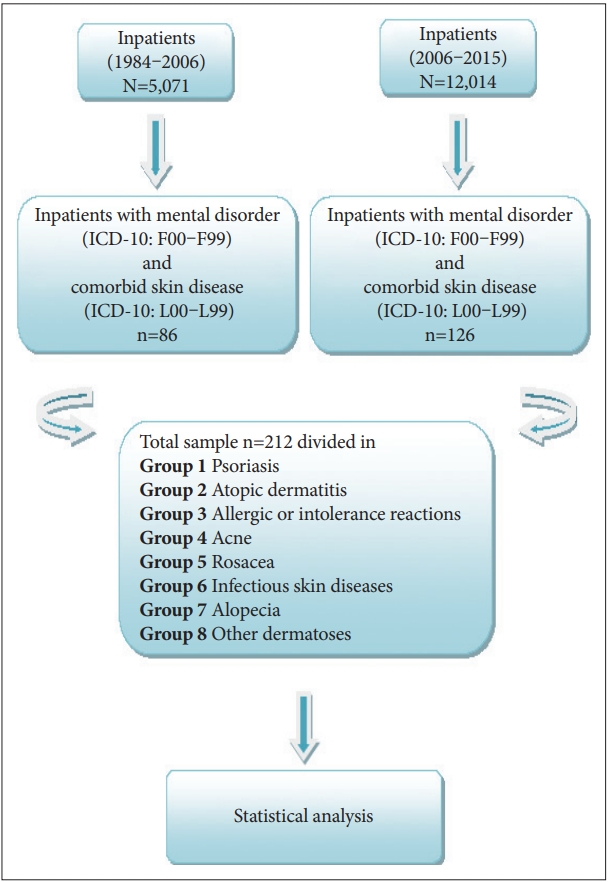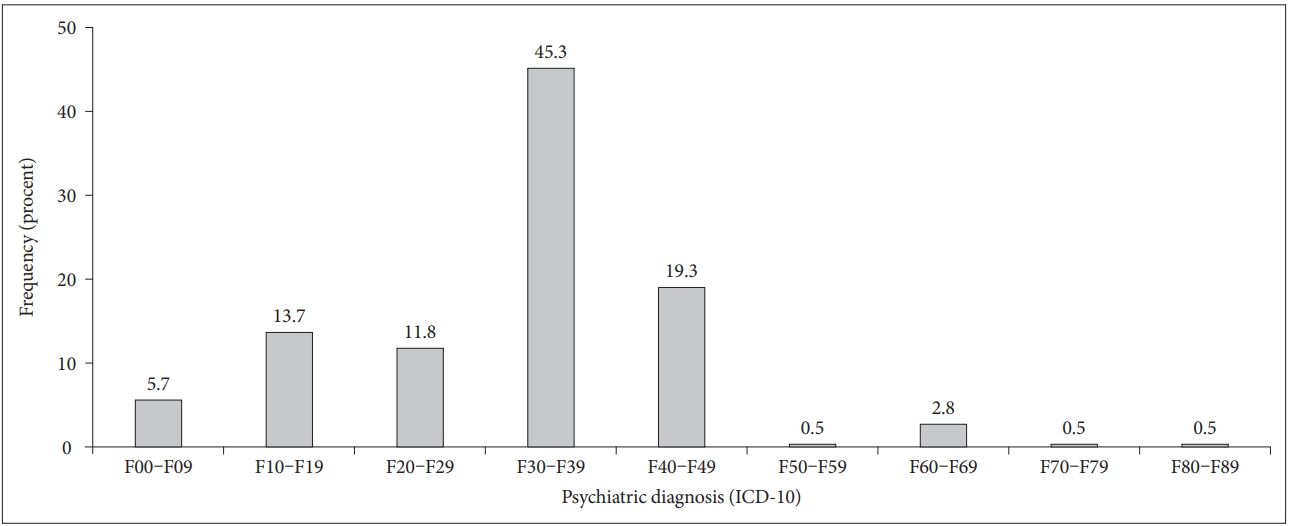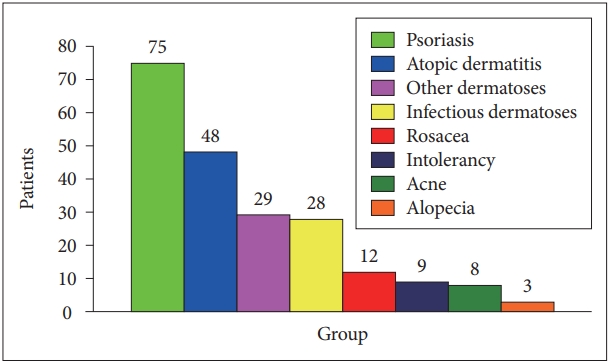2. Picardi A, Abeni D, Melchi CF, Puddu P, Pasquini P. Psychiatric morbidity in dermatological outpatients: an issue to be recognized. Br J Dermatol 2000;143:983-991.


3. Cvetkovski RS, Zachariae R, Jensen H, Olsen J, Johansen JD, Agner T. Quality of life and depression in a population of occupational hand eczema patients. Contact Dermatitis 2006;54:106-111.


4. Kurd SK, Troxel AB, Gelfand JM. The risk of depression, anxiety, and suicidality in patients with psoriasis: a populationbased cohort study. Arch Dermatol 2010;146:891-895.


5. Boehm D, Schmitt-Ott G, Finkeldey F, John SM, Dwinger C, Werfel T, et al. Anxiety, depression and impaired-related quality of life in patients with occupational hand eczema. Contact Dermatitis 2012;67:184-192.


6. Onderdijik AJ, van der Zee HH, Esmann S, Lophaven S, Dufour DN, Jemec GB, et al. Depression in patients with hidradenitis suppurativa. J Eur Acad Dermatol Venereol 2013;27:473-478.


7. Sanna L, Stuart AL, Pasco JA, Jacka FN, Berk M, Maes M, et al. Atopic disorders and depression: findings from a large, population-based study. J Affect Disord 2014;155:261-265.


8. Mookhoeck EJ, Van De Kerkhof PC, Hovens JE, Brouwers JR, Loonen AJ. Skin disorders in chronic psychiatric illness. J Eur Acad Dermatol Venereol 2010;24:1151-1156.


11. Brown GE, Malakouti M, Sorenson E, Gupta R, Koo JY. Psychodermatology. Adv Psychosom Med 2015;34:123-134.


12. Nowak DA, Wong SM. DSM-5 update in psychodermatology. Skin Therapy Lett 2016;21:4-7.

13. Kuhn H, Mennella C, Magid M, Stamu-OŌĆÖBrien C, Kroumpouzos G. Psychocutaneous disease: pharmacotherapy and psychotherapy. J Am Acad Dermatol 2017;76:795-808.


14. Koo J, Marangell LB, Nakamura M, Armstrong A, Jeon C, Bhutani T, et al. Depression and suicidality in psoriasis: review of the literature including the cytokine theory of depression. J Eur Acad Dermatol Venereol 2017;31:1999-2009.


15. Petraskiene R, Valiukeviciene S, Macijauskiene J. Associations of the quality of life and psychoemotional state with sociodemographic factors in patients with psoriasis. Medicina (Kaunas) 2016;52:238-243.


17. Dowlatshahi EA, Wakkee M, Arends LR, Nijsten T. The prevalence and odds of depressive symptoms and clinical depression in psoriasis patients: a systematic review and meta-analysis. J Investig Dermatol 2014;134:1542-1551.


19. Yu SH, Silverberg JI. Association between atopic dermatitis and depression in US adults. J Invest Dermatol 2015;135:3183-3186.


20. Eckert L, Gupta S, Amand C, Gadkari A, Mahajan P, Gelfand JM. Impact of atopic dermatitis on health related quality of life and productivity in adults in the United States: an analysis using the National Health and Wellness Survey. J Am Acad Dermatol 2017;77:274-279.


21. Lee SH, Lee SH, Lee SY, Lee B, Lee SH, Park YL. Psychological health status and health-related quality of life in adults with atopic dermatitis. A nationwide cross-sectional study in South Korea. Acta Derm Venereol 2018;98:89-97.


22. Nicholas MN, Gooderham M. Psoriasis, depression, and suicidality. Skin Therapy Lett 2017;22:1-4.
23. Dieris-Hirche J, Gieler U, Petrak F, Milch W, Te Wildt B, Dieris B, et al. Suicidal ideation in adult patients with atopic dermatitis: a German cross-sectional study. Acta Derm Venereol 2017;97:1189-1195.


26. Ferreira BR, Da Costa Abreu JL, Dos Reis JP, Figueiredo AM. Psoriasis and associated psychiatric disorders: a systematic review on etiopathogenesis and clinical correlation. J Clin Aesthet Dermatol 2016;9:36-43.
27. Kwak Y, Kim Y. Health-related quality of life and mental health of adults with atopic dermatitis. Arch Psychiatr Nurs 2017;31:516-521.


28. Strober B, Gooderham M, de Jong EMGJ, Kimball AB, Langley RG, Lakdawala N, et al. Depressive symptoms, depression, and the effect of biologic therapy among patients in Psoriasis Longitudinal Assessment and Registry (PSOLAR). J Am Acad Dermatol 2018;78:70-80.


29. Thyssen JP, Hamann CR, Linneberg A, Dantoft TM, Skov L, Gislason GH, et al. Atopic dermatitis is associated with anxiety, depression, and suicidal ideation, but not with psychiatric hospitalization or suicide. Allergy 2018;73:214-220.


33. Hu SC, Lan CE. Psoriasis and cardiovascular comorbidities: focusing on severe vascular events, cardiovascular risk factors and implications for treatment. Int J Mol Sci 2017;18:pii: E2211.

36. Egeberg A, Khalid U, Gislason GH, Mallbris L, Skov L, Hansen PR. Impact of depression on risk of myocardial infarction, stroke and cardiovascular death in patients with psoriasis: a Danish nationwide study. Acta Derm Venereol 2016;96:218-221.


37. Gupta AK, Gupta G, Jain HC, Lynde CW, Foley KA, Daigle D, et al. The prevalence of unsuspected onychomycosis and its causative organisms in a multicentre Canadian sample of 30000 patients visiting physiciansŌĆÖ offices. J Eur Acad Dermatol Venereol 2016;30:1567-1572.


38. Chagon A, Franca K, Fernandez A, Nouri K. Psychosocial impact of onychomycosis: a review. Int J Dermatol 2013;52:1300-1307.


39. Sakka N, Shemer A, Barzilai A, Farhi R, Daniel R. Occult tinea pedis in an Israeli population and predisposing factors for the acquisition of the disease. Int J Dermatol 2015;54:146-149.


40. Wu BY, Wu BJ, Lee SM, Sun HJ, Chang YT, Lin MW. Prevalence and associated factors of comorbid skin diseases in patients with schizophrenia: a clinical survey and national health database study. Gen Hosp Psychiatry 2014;36:415-421.


41. Kawai M, Suzuki T, Hiruma M, Ikeda S. A retrospective cohort study of tinea pedis and tinea unguium in inpatients in a psychiatric hospital. Med Mycol J 2014;55:E35-E41.














